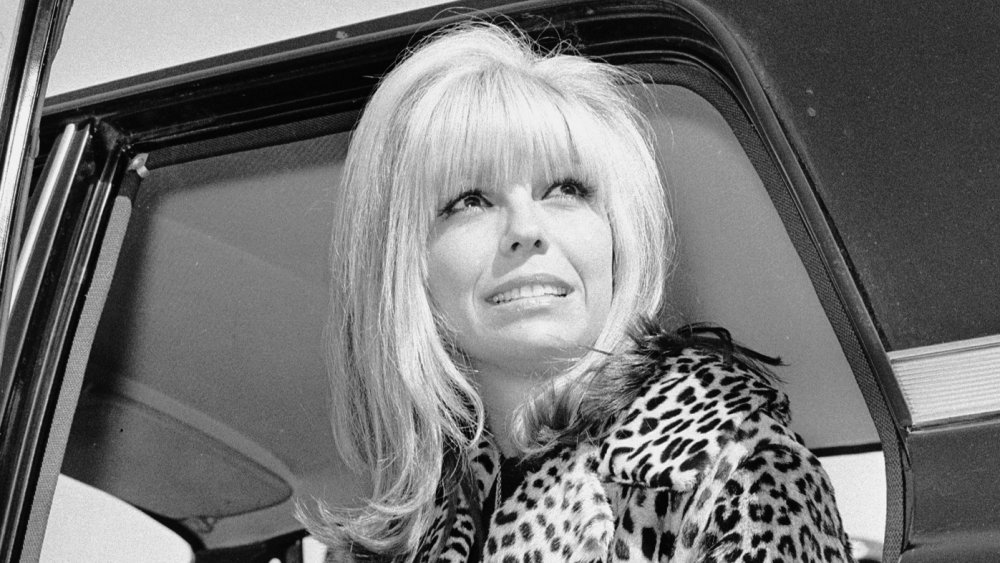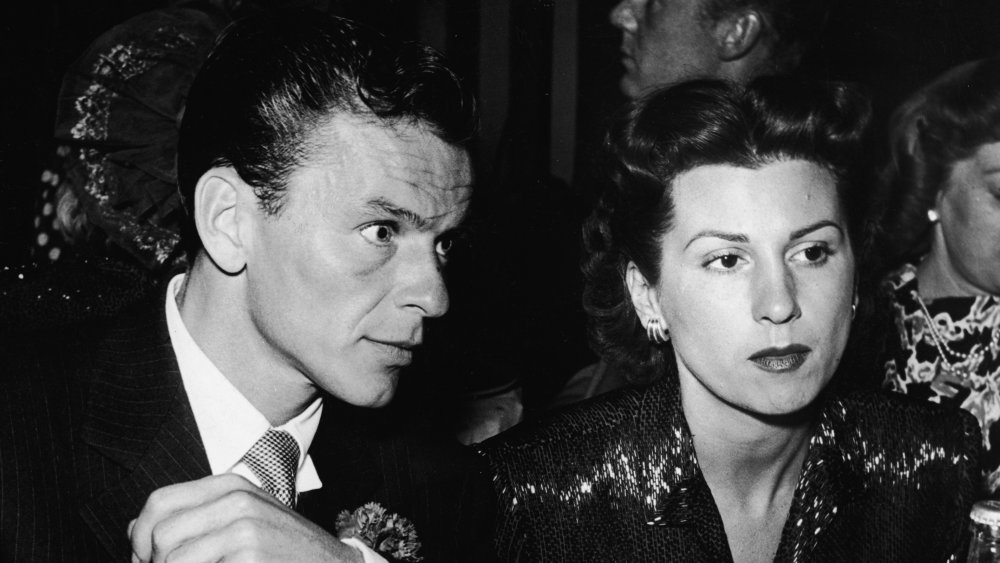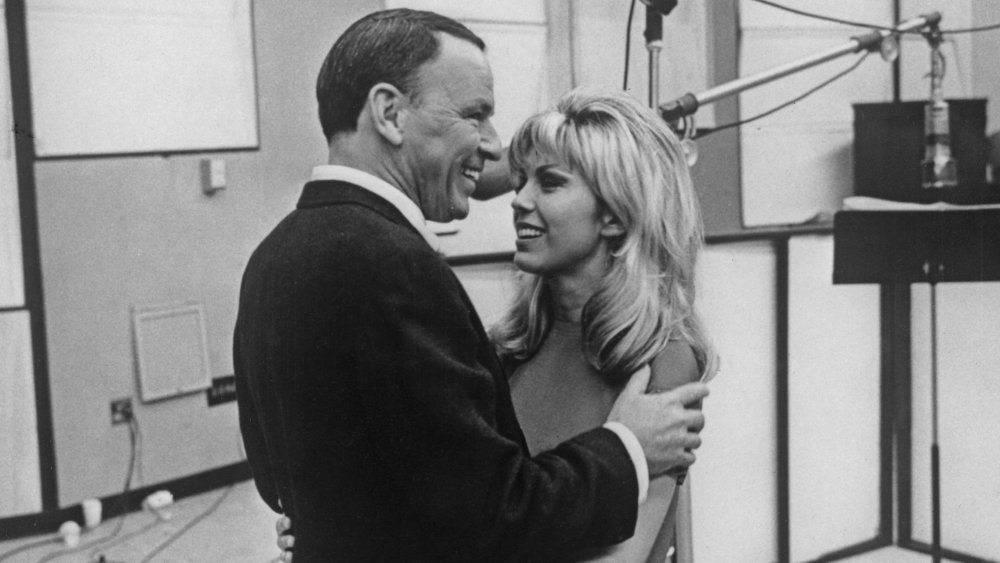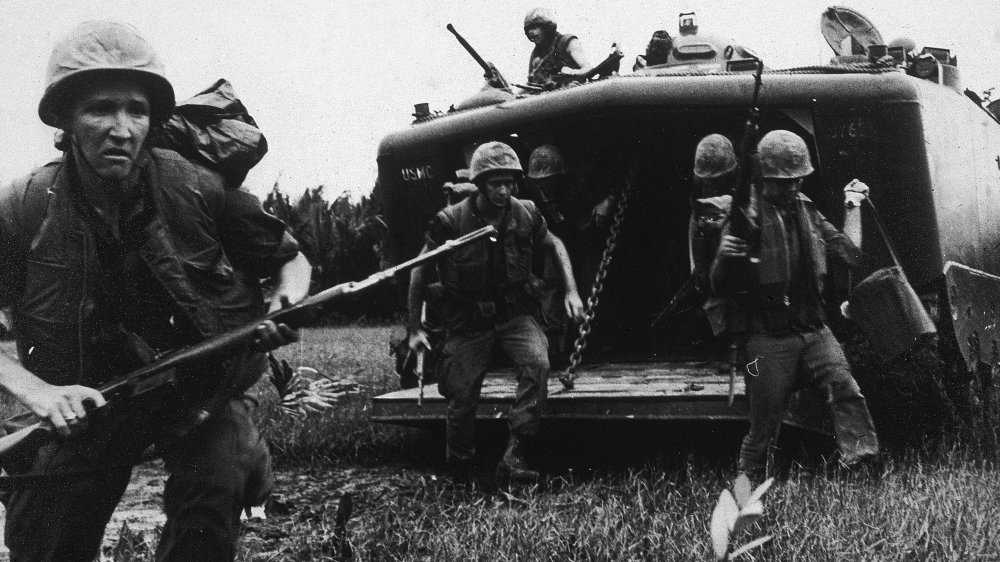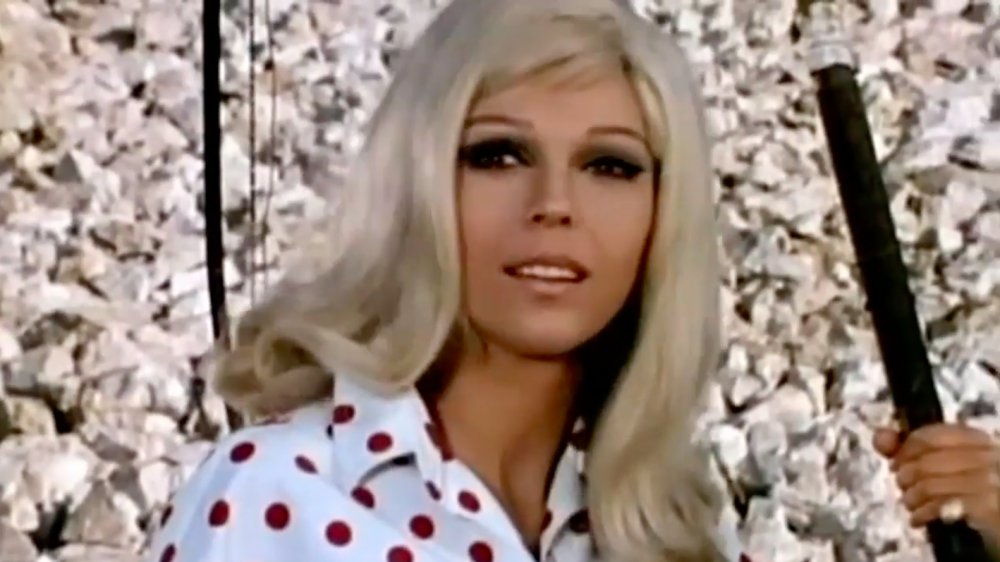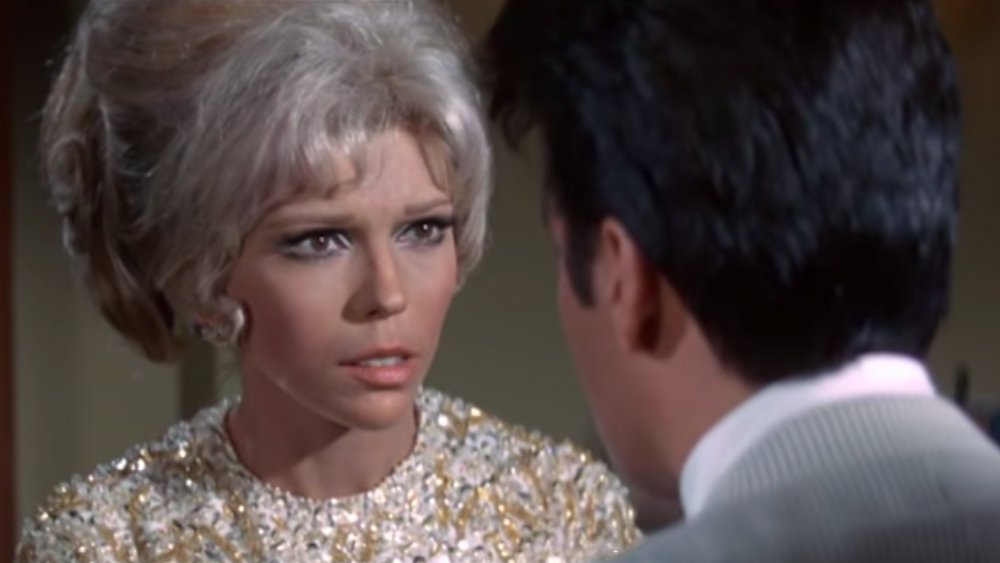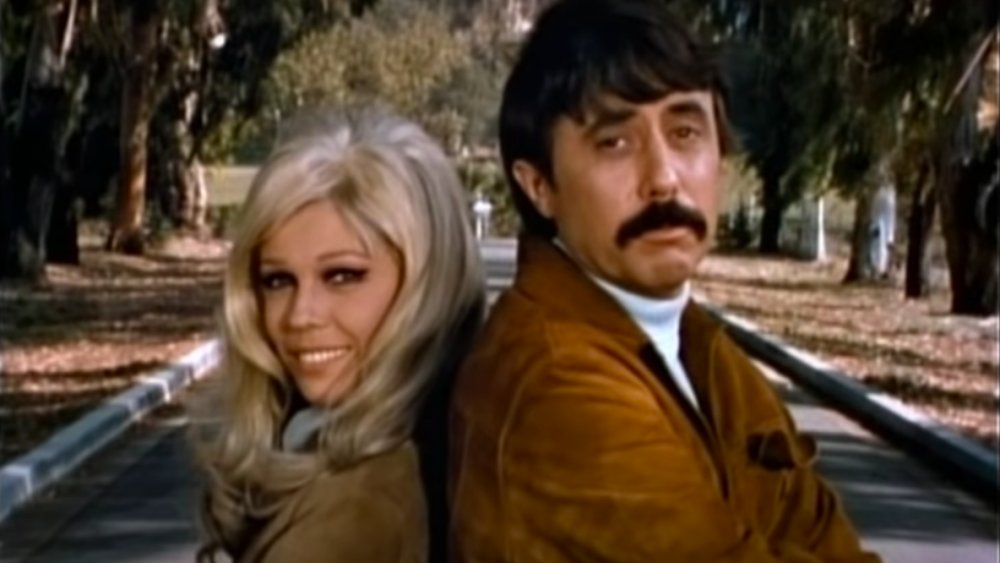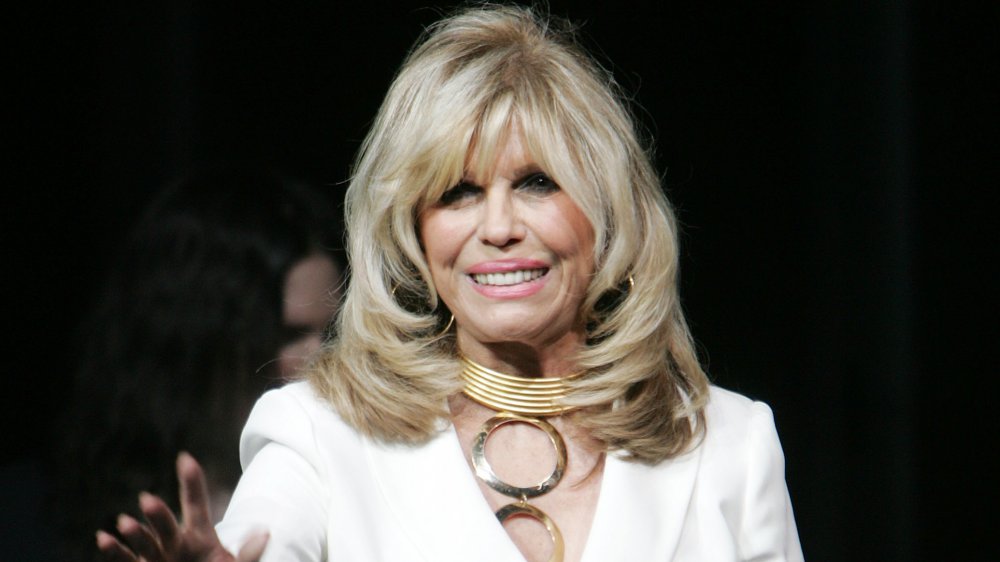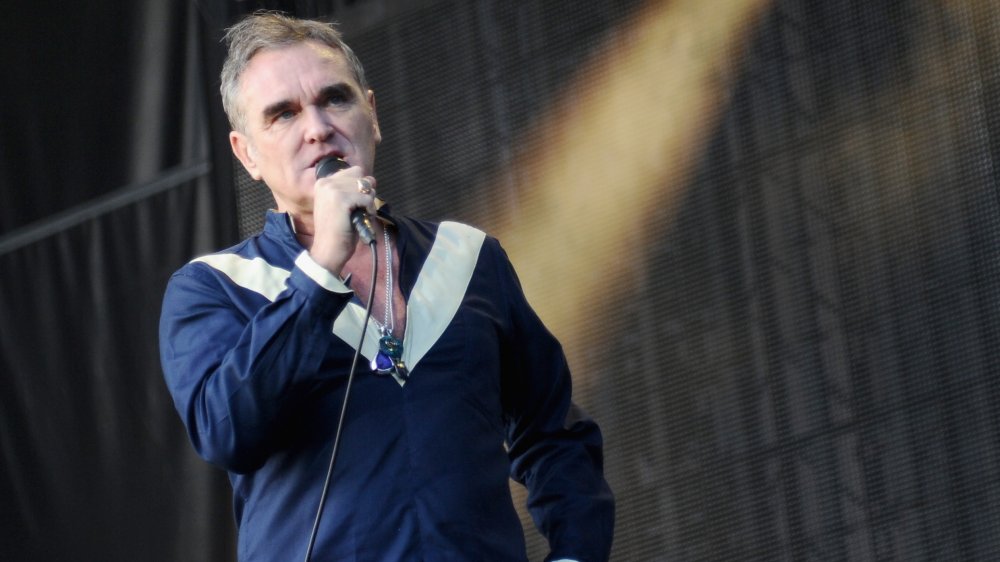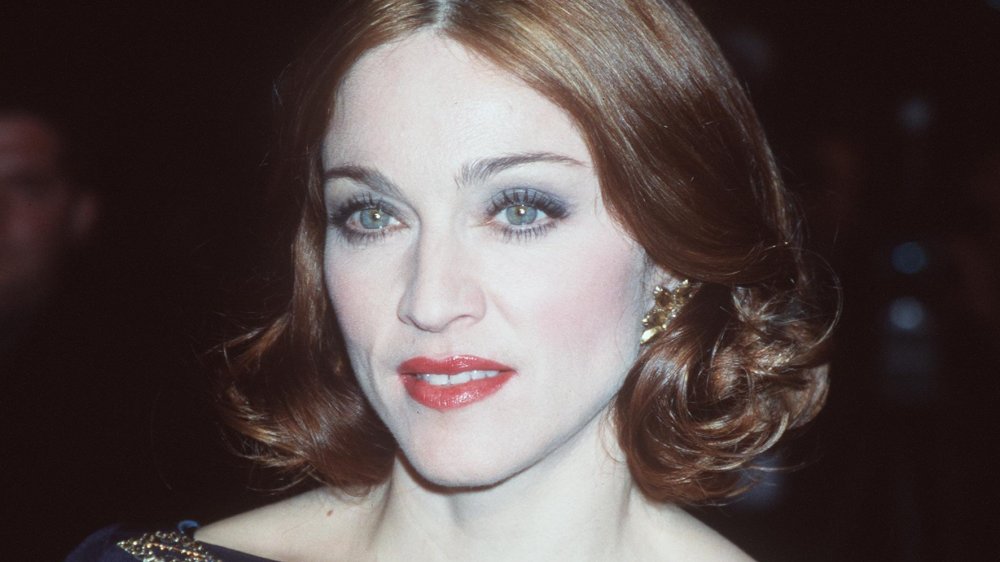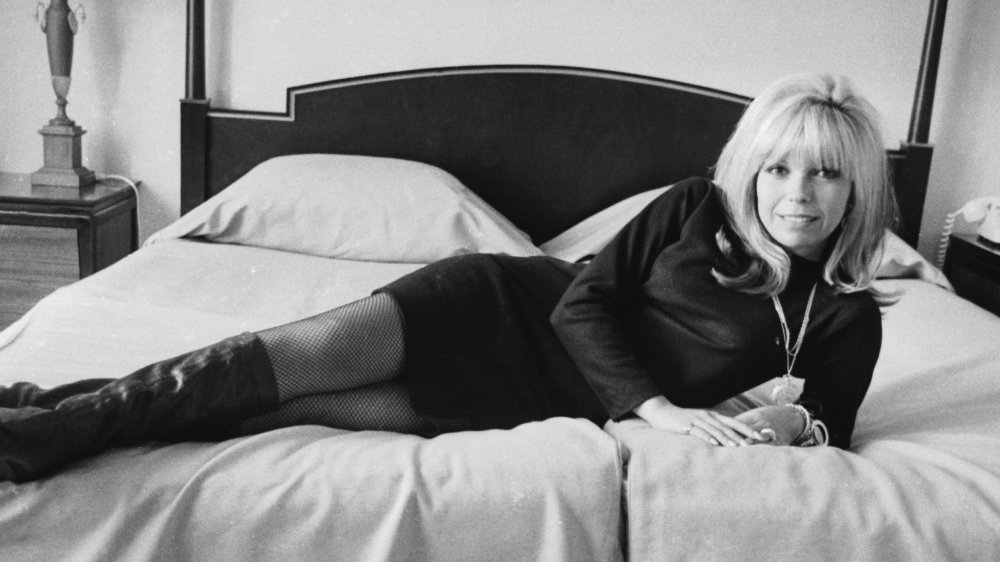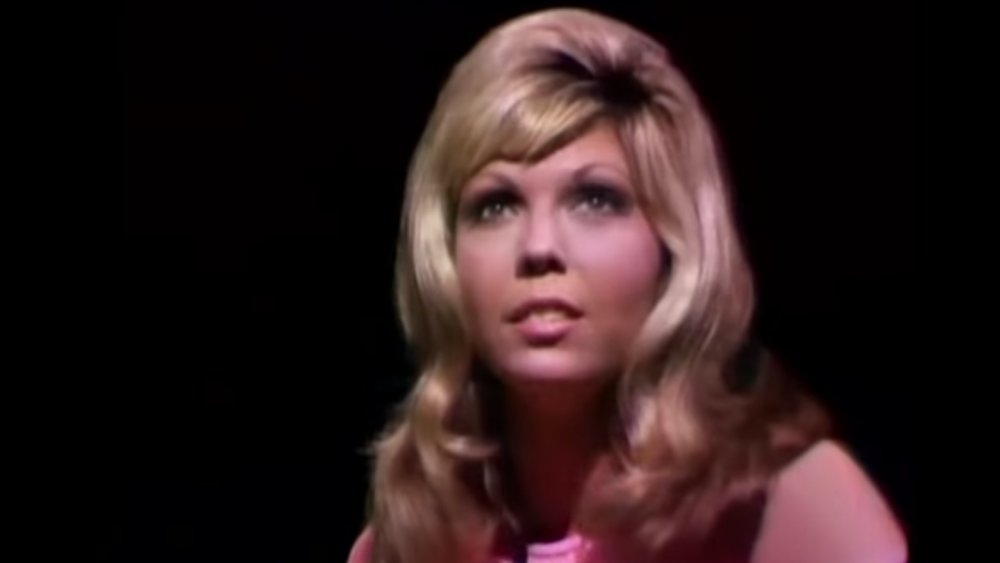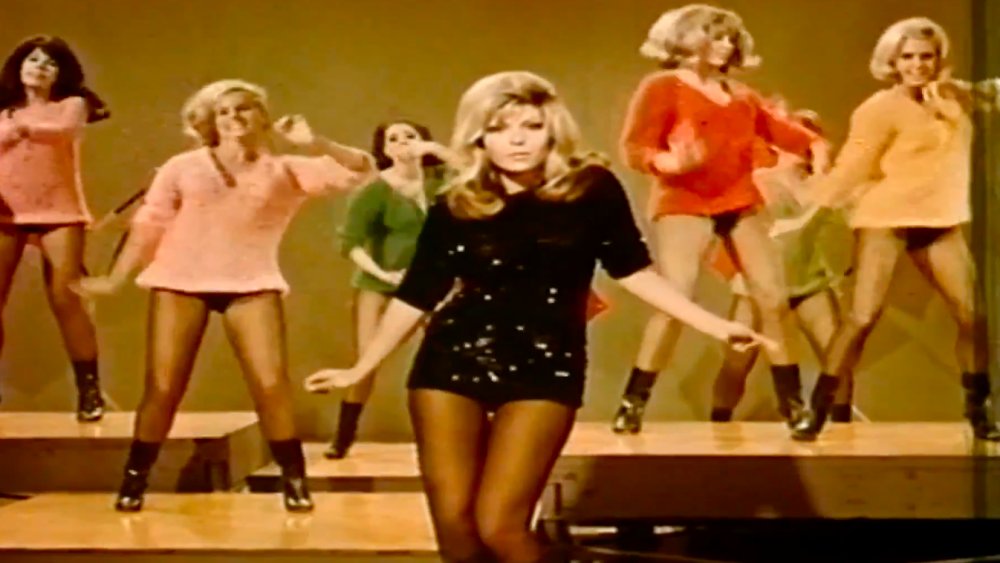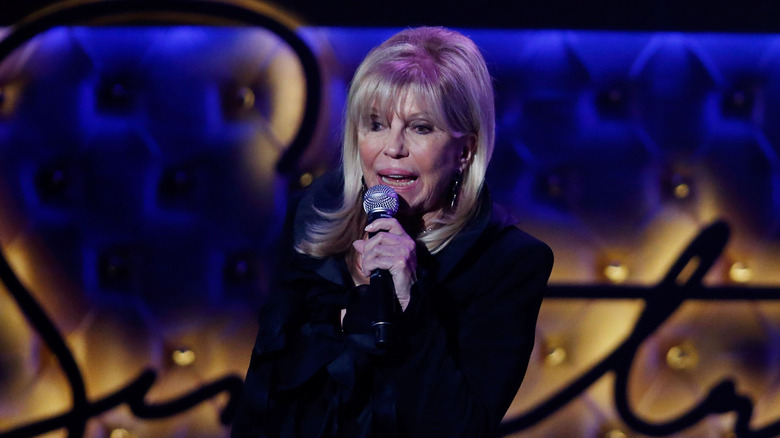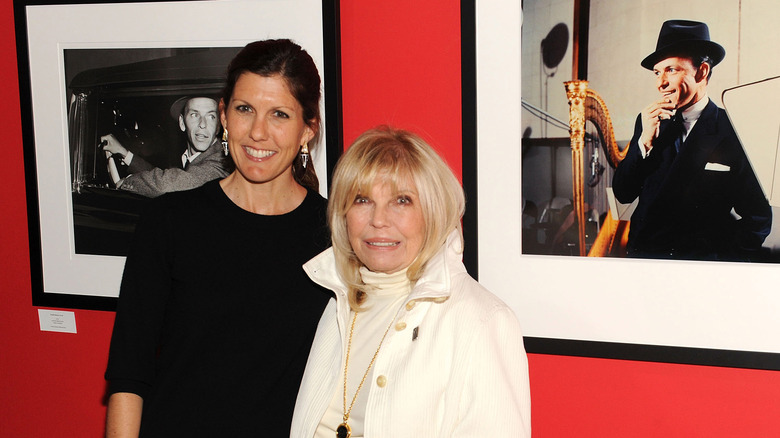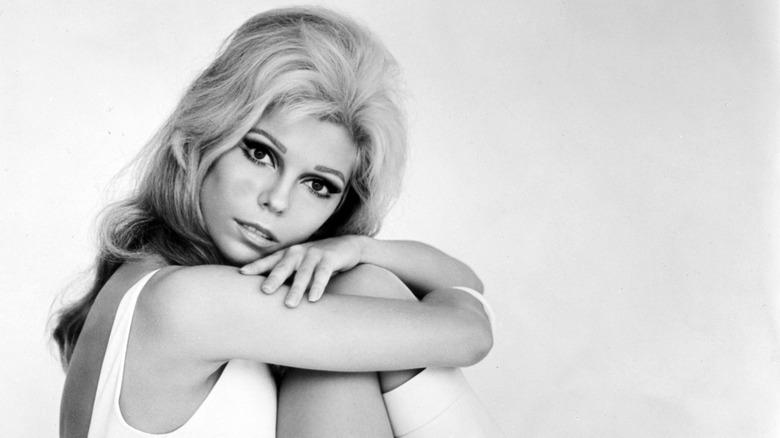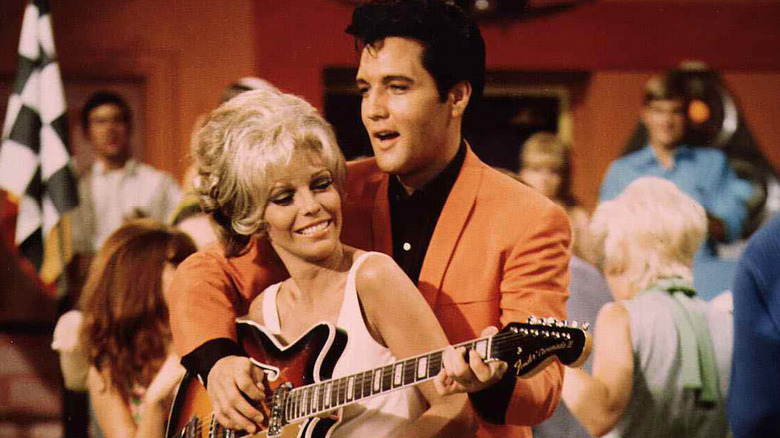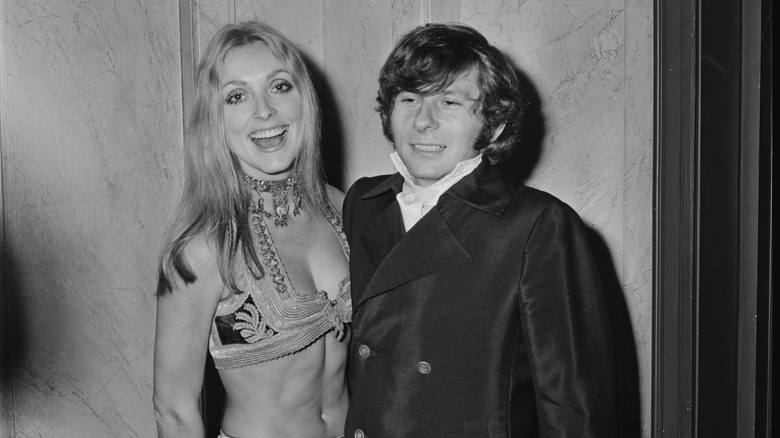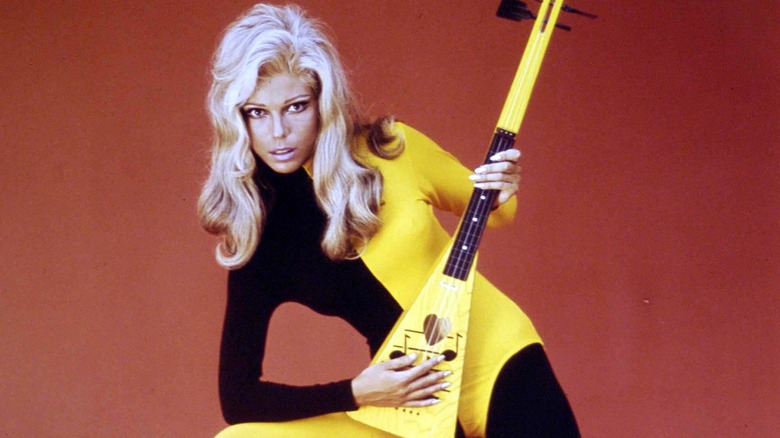The Untold Truth Of Nancy Sinatra
A glamorous starlet synonymous with go-go boots and a sex symbol of the swinging '60s, Nancy Sinatra will forever be remembered for her hits such as "These Boots Are Made For Walkin'," "Sugar Town," and the 1967 James Bond theme, "You Only Live Twice." Although the songstress had a helping hand from her famous father, Frank Sinatra, Nancy unmistakably carved her own path, one separate and (some would argue) just as iconic as Ol' Blue Eyes himself.
"[It] wasn't always easy," the Speedway actress told the Independent of growing up with such a legendary last name. "It certainly opened doors ... but it closed a lot more." Nevertheless, pipes truly ran in the family, and Nancy solidified herself as a talented singer in her own right, commandeering a whopping 22 Top 10 singles between 1966 and 1972.
According to the Independent, the "Lady Bird" crooner suddenly left the limelight in 1972 in order to start a family. "The music industry is very ruthless," she mused to the outlet in 2004. "People forget extremely quickly." That being said, Nancy is a Sinatra, after all, and has managed to withstand the test of time — cropping up in the most unexpected of places. Here is the untold truth of Nancy Sinatra.
Nancy Sinatra wasn't initially born into money
It's easy to imagine Nancy Sinatra coming out of the womb harmonizing "You Make Me Feel So Young" with her blue-eyed pops. Whether or not that was the case, it looks like the future starlet had pretty humble beginnings. Born in 1940 in Jersey City, N.J. to Frank Sinatra and his wife at the time, Nancy Barbato Sinatra, Nancy was the eldest of the couple's three children. As the songstress told The Guardian, she wasn't exactly born with a silver spoon in her mouth. In fact, Nancy's father wasn't even "on the map" when she was born, only rising to the top as a solo artist in 1943, or as Nancy put it, "once he hit, he really hit." So, what did hitting it big exactly mean? Well, as The Guardian details, people started sneaking around their house to take a peek of the star, which caused Nancy's mother to worry her children would get kidnapped.
Sure enough — albeit years later in 1963 — Nancy's younger brother, a then-18-year-old Frank Sinatra Jr., was taken from a Lake Tahoe casino, only released after two days when Frank paid a $250,000 ransom to the kidnappers.
Eventually, the family moved out west to Toluca Lake in Los Angeles so Frank could be close to Hollywood. Nancy's upbringing suddenly turned into a constant A-list soirée, and as she revealed to The Guardian, "Frequent guests included comedians Jack Benny, George Burns, and Gracie Allen."
Nancy and Frank Sinatra recorded what some believed was the 'Incest Song'
"These Boots Are Made For Walkin'" aside, another one of Nancy Sinatra's biggest hits is her 1967 duet with Frank Sinatra, "Somethin' Stupid." It wasn't only a big success for Nancy, either, as, according to Stereogum, Frank was amid a "career comeback," with the track co-produced by Jimmy Bowen — the man responsible for Frank's "big comeback hits" of the time.
While the song to this day remains the only father-daughter duet to hit No. 1 on Billboard's Hot 100, it left some audiences feeling, well, a bit disturbed. "Some people call that the Incest Song," Nancy explained to The Guardian in 2008. In fact, just a quick listen of the song reveals that it's clearly romantic in nature. So, what gives? Per Stereogum, "Somethin' Stupid" was initially written by Carson Parks — who recorded it with his wife, Gaile Foote. According to the Independent, thanks to a contract with Frank's team, "Somethin' Stupid" found its way to Nancy's producer at the time, Lee Hazlewood. He told Frank, "I love it, and if you don't sing it with Nancy, I will." Frank booked a studio shortly afterward.
At the end of the day, it looks like the Sinatras didn't follow their own advice. "Just stay away from what I do," Frank told his daughter at the start of her music career (via The Guardian). "You'll be up for comparisons, and it'll be ridiculous."
Her boots walked all the way to Vietnam
Nancy Sinatra's success with the release of "These Boots Are Made For Walkin'" in 1966 coincided with the ramping up of the Vietnam War — and her popularity only grew that same year as US troops stationed in the country rose to 400,000. With her bleached blonde hair and mesmerizing sphinx-like makeup, Nancy and her go-go boots became pop-culture icons outside of America. In fact, as The Guardian reveals, she "was the most popular pinup for the GIs in Vietnam."
The New Jersey-born starlet decided to take her newfound popularity into the heart of "the war zone," keeping morale high for the troops stationed so far away from home. As Nancy's escort officer, Frank Livolsi, told Geraldo Rivera in 1995, her first visit to Vietnam saw her staying there for three weeks, touring the country "from north to south." As for the troop's response? "She just made a great impression everywhere she went," adding that her presence "[helped] boost [the] moral" of the GIs fighting.
For 1967's French war documentary, The Anderson Platoon, you can hear Nancy's single play over the clips of soldiers heading into the battlefield. It looks like her fans returned the favor, and as Motion Pictures From the Fabulous 1960's writes, soldiers adopted her boot-clinking classic as their "theme song" before trudging into battle.
Nancy Sinatra killed the radio star
Many think of The Buggles' 1981 release of "Video Killed the Radio Star" as the first-ever music video on MTV — one that wasn't filmed in front of a studio audience and without an introduction. That being said, what if someone else pioneered the idea first?
Nancy Sinatra released her television special, Movin' With Nancy, in 1967, featuring fellow industry legends such as Dean Martin, Lee Hazlewood, Sammy Davis Jr., and, of course, Frank Sinatra. As PR.com writes, the hour-long special "was the first of its kind," including "a series of seamlessly strung together musical vignettes." Jack Haley, Jr., the director behind the special, had a passion for movie musicals and was set on bringing the aspect of song and dance onto the television format. Tom Mankiewicz, Movin' With Nancy's writer, elaborated on this idea further in his book, My Life as a Mankiewicz, adding that the writing focused on "setting the songs to their proper backgrounds and locations, telling the story." The verdict? Haley Jr. took home an Emmy for Outstanding Directorial Achievement, and Nancy solidified herself as an "It" girl of the '60s.
Movin' With Nancy didn't just pioneer the later-coined "music video," however. As it turned out, it also included one of the first interracial kisses on television — between Sammy Davis, Jr. and Nancy Sinatra. "It caused some controversy then, and now," the songstress recalled to PR.com in 2011, adding that contrary to online reports, it was "unplanned and spontaneous."
Spoiler alert: Elvis Presley was a 'great kisser'
Nancy Sinatra met Elvis Presley for the first time in 1960, just as the King was coming home from the army. When your father happens to be Frank Sinatra, rubbing elbows with the industry's finest is just another day in the life. Casual, you know?
By 1968, after she solidified herself as a crooning icon in her own right, Nancy starred in Speedway alongside Elvis, and, of course, rumors began circulating that these two A-listers were an item. The "Sugartown" singer finally addressed the gossip in 1995 while on Geraldo Rivera's talk show, admitting that while the pair had a "friendly" flirtation, nothing ever progressed past that. Perhaps the buzz surrounding the duo had something to do with their time spent together on set, where Elvis had a tandem bike built for the two of them. "He'd say: 'Nancy, let's go for a ride' and then we'd go off," Nancy recalled to Daily Mail, adding, "within seconds all these Elvis fans would descend on us."
Years later, it looks like Nancy still remembers the King fondly. Joking to Conan O'Brien that Elvis was "a great kisser," she also admitted that the pair took their friendship off-set, as well, with the "Jailhouse Rock" singer even calling her the night his daughter, Lisa Marie Presley, was born.
Lee Hazlewood taught Nancy Sinatra how to sing
While it's easy to deduce that Frank Sinatra may have helped his daughter blossom into a singer, it's actually Nancy Sinatra's producer, Lee Hazlewood, who fine-tuned her vocals in the mid-60s. "If it weren't for Lee, I wouldn't be the singer I am today," Nancy recalled to Independent in 2004. "He taught me to sing lower and to sing tough."
On the other hand, Lee is a bit more ruthless with his retelling of their collaborative efforts, imitating Nancy's initial high-pitched tone. "We lowered her singing about two keys," he told The Telegraph. Nancy's reaction? "I can do that." Just like that, hits such as "These Boots Are Made For Walkin'" were born, and the rest was history.
Nancy returned the favor to Lee, and when the time came for her record label to suggest pairing her up with someone for a duets album, she demanded her partner be her musical mentor. The result was Nancy & Lee, an album that The Guardian calls the "finest fruit of [their] collaboration." Perhaps they would have recorded more records together, too, but Lee was the cause of their relationship going sour for many years after he hopped on a plane to Sweden (and surprisingly not Jackson) in 1970 while the pair were in the middle of recording another collaborative album.
She did Playboy to 'churn things up'
Although Nancy Sinatra was a bona fide pop icon by the late '60s, what she did next was totally unexpected: she chose to duck out of the spotlight in 1972 to start a family. "It's what you did then," the singer explained to the Independent. "You got married and concentrated on your family. I was raised as a Catholic and as an Italian so there was no question of doing it any other way."
Suddenly, in 1995, Nancy made her return to the limelight just shy of her 55th birthday — in the form of a Playboy pictorial. "I think it's obvious I did this to churn things up a little bit," Nancy told Entertainment Tonight, adding, "In the 90s, what [else] do you do?" As she further explained to Jon Stewart, she was "scared to death" of the shoot, adding that it's only with age that she got the courage to pose for the legendary magazine.
Surprisingly, Nancy's family supported her — even the very Catholic Frank Sinatra, who listened to his daughter's pitch and simply told her to "double" the amount Hugh Hefner was going to pay her. "Apparently, he thought that our name was worth more," Nancy recalled to Entertainment Tonight. Guess what? It was.
Morrissey was also Nancy Sinatra's mentor
The mid-90s really shook things up for Nancy Sinatra, allowing her to evolve from the go-go boot-wearing vixen of the 60s. In 1995, the same year that she posed for Playboy, Nancy met Morrissey for the first time after he asked her to sign some records for him. Surprisingly enough, the starlet found herself drawn to The Smiths frontman — as he reminded her of Frank Sinatra. "There are people who live for Morrissey, just like they lived for my dad," Nancy told the Independent in 2004, adding, "On stage, they are very similar, too — the body language, the strong voice, that same magnetic quality ... It's spooky."
By 2004, Morrissey had written a song for Nancy and tapped into the icon's love for crooning. "[He] said I have a song for you and if you sing it and we release it as a single, you'll be on the charts for the first time since 1972," she recalled to The Telegraph. That same year, they released the track, "Let Me Kiss You," and just as the Hatful of Hollow hitmaker predicted, the single reached spot 46 on the Official UK Top 40 chart.
Nancy isn't shy to list Morrissey as another one of her mentors alongside the legendary Lee Hazlewood. "He told me not to give up on myself, and that I have a voice that is still worth hearing," the singer revealed to the Independent. "I owe him so much."
Madonna fantasized she could be Nancy Sinatra
When Madonna burst onto the scene in 1983, she was credited for jumpstarting the trend of women unapologetically owning their sexuality. While she certainly took things to a whole other level with what The New York Times dubbed her "flagrant exhibitionism," it's actually Nancy Sinatra who paved the way for generations to come.
"It was before feminists and all that. I was one of the first women's libbers," Nancy recalled to Jon Stewart of the positive feminist message that surrounded her hit, "These Boots Are Made For Walkin'." She echoed a similar sentiment while on The Howie Mandel Show, explaining, "It was a song that Lee Hazlewood wrote and sang ... and I said to him, 'You shouldn't sing that because a man shouldn't sing that song. A woman should sing that song.'" Nancy made the right call and only pushed herself further with her feminist statements. As Jay Leno revealed in 1995, Nancy's 1967 album, Sugar, was banned in Boston at the time of its release due to its album cover's provocative nature.
Coming full circle, it looks like Madge drew inspiration from Nancy early on. Speaking with Island Magazine (via All About Madonna) in 1983, one of Madonna's "oldest fantasies" was to be Nancy Sinatra, and she admitted to performing "These Boots Are Made For Walkin'" standing "in front of the mirror in [her] uniform skirt."
Nancy Sinatra: an indie-rock star?
Nancy Sinatra's comeback in 2004 took the form of an unexpected genre: indie-rock. In fact, the starlet herself knows she may not exactly fit in. "Rock is a business for young people," she told The New York Times that year. "It's not for people who care about things like hair and makeup." It's not the first time the singer changed her image, either, as Nancy was ridiculed even at the start of her career for her wholesome nature. "I used to be called Nancy Nice Lady," the singer recalled to The Telegraph, adding that when she first began working with producer Lee Hazlewood, he told her to "get rid of that," and in turn, nicknamed her "Nasty Jones."
While Nasty Jones didn't stick in terms of mass appeal, Nancy was still edgy enough to snag some of rock's finest for her comeback album, Nancy Sinatra, including the likes of Morrissey, Jarvis Cocker of Pulp, Jon Spencer, and U2's Bono. As for public opinion? The Guardian, for example, praised, "Most of these collaborations fit like exquisite kid gloves," giving it four stars out of five.
So, where did Nancy get the idea to kick off her knee-high boots? Citing her daughter, AJ, Nancy told the Independent, "She kept saying, 'Mom, you're making the wrong kind of music, you need to tap into a whole different age group.'"
One of her most popular songs was actually a cover
You can thank Quentin Tarantino for this one. Back in the 60s, artists used to cover each other's singles left, right, and center. For example, the iconic Aretha Franklin song, "Respect," was originally recorded by Otis Redding two years prior to her 1967 hit. As for Nancy Sinatra, her 1966 tune, "Bang Bang (My Baby Shot Me Down)," was a Cher original released that same year.
As Nancy's guitarist for the track, Billy Strange, explained to Lost and Sound, the cover initially didn't do much for the crooner's career, revealing, "It didn't make a big impact. Cher's original version was a big hit, though."
Thankfully for Nancy, her luck shifted after Tarantino decided to use her cover as the theme song for his 2003 critically acclaimed flick, Kill Bill: Volume 1. "I think you'll have a hard time hearing that after seeing the movie and not thinking about the bride lying in the church," the director told the Los Angeles Times before the movie's release. "That was in my head six years ago when I first came up with Kill Bill." As for Nancy, she's forever grateful. As she gushed to The Telegraph, "That was a real gift that Quentin gave me."
Nancy Sinatra doesn't think her music gets the respect it deserves
While Nancy Sinatra knows her famous last name helped her embark on her singing career, she also cites it as a massive flaw. "My peers don't care," she told The Telegraph in 2004. "To them, I'm Frank [Sinatra's] daughter." She echoed a similar, albeit more blunt sentiment to Pop Matters, revealing that she was regularly "sloughed off as an airhead."
While some would argue that some of the starlet's most high-profile fans, such as Morrissey and Quentin Tarantino, have helped keep her legacy alive, perhaps it comes down to something else. Simply put, Miss Sinatra's pipes have aged like a fine wine. As The Baltimore Sun wrote of her self-titled 2004 album, Nancy's voice has become "refined," adding that "age has certainly helped the quality of her pipes, deepening the sound a bit and giving it strength." As it turned out, Nancy has kept up with her vocal training throughout the years and vocalizes "everyday."
When it comes down to it, maybe Nancy Sinatra has finally found her groove within a younger generation. As for seeking credit? The starlet shrugs it off. "When I die, I already know what my obituary will be," she quipped to Pop Matters. "'Frank's daughter died with her boots on!' Ha."
Nancy Sinatra refuses to speak Donald Trump's name
During Donald Trump's inauguration in 2017, his first dance with his wife Melania was to Frank Sinatra's '60s hit, "My Way." Years later, in 2021, when his presidency came to a close, Trump climbed aboard Air Force One for a final time, playing the same song. So, does the real estate mogul have any warm ties to the Sinatras? As Nancy Sinatra revealed to The Guardian, not a chance.
Frank, who died in 1998, sang at the Trump-owned Atlantic City casino in 1990, asking for his fee after his performance. After Trump refused to pay up, the singer allegedly told him to "go f*** himself." It appears that Frank's hatred for The Donald was passed on to his daughter, who refuses even to say Trump's name during casual conversation. "I've always tried desperately never to mention it, and if I did it would have been with a lowercase 't,'" she declared to The Guardian.
As for Trump's insistence on playing "My Way" twice during his presidency? Nancy is unbothered, explaining to the Independent that neither she nor her famous father was ever really fans of the track. "It's a terrible song," she declared. At the same time, the '60s icon notes something remarkably prescient about the first line of the tune, where her father sings, "and now the end is near": "[it's] a perfect, perfect first line for him. It took a little longer than I'd hoped — but it ended."
The state of the world has Nancy Sinatra feeling blue
Gone is Nancy Sinatra's heyday of the 1960s, where she soared to the top of the charts with her 1966 hit, "These Boots Are Made for Walkin'." Per Biography, she left the music biz in the '80s to raise her children, only to return in the mid-'90s. Since then, she's been in the industry on and off, certainly not gaining as much publicity as she once did.
When the COVID-19 pandemic hit in 2019, Sinatra was 79 — her children were well into adulthood, while the crooner's husband, Broadway dancer Hugh Lambert, passed away decades earlier, in 1985. According to an interview she had with The Guardian in 2021, spending so much time in isolation by herself, Sinatra grew saddened about the state of the world. "It's a long time to be alone. No hugging, you know?" she mused.
But it's not just the pandemic that has the "Sugar Town" hitmaker feeling blue. Noting the political unrest within the United States that had cropped up in recent years, Sinatra deduced, "I hope we can get back to the freedoms we enjoy ... I don't want my granddaughters to grow up in a nation full of hate" (via The Guardian).
Her daughter helped her get back into the music business
In the early 2000s, Nancy Sinatra gave up touring entirely, instead choosing to head back into the studio every so often (via Rolling Stone). According to Biography, she released albums in 2003 and 2004 before turning to host radio shows, such as Sirius' "Nancy for Frank" and "Siriusly Sinatra." So, was age a factor in Sinatra's slow fade out of the limelight? Not exactly.
As the singer told Rolling Stone in 2021, the main reason she slowed down musically was due to the lack of an agent — a crucial factor for promotion. "If you're an artist who used to be famous, you kind of need a leg up — you need somebody to represent you," she explained. However, that same year, an 80-year-old Sinatra surprised her long-term fans with "Start Walkin' 1965-1976" — a collection that included reissues of some of her greatest hits. It turns out, the pop icon's daughter, Amanda Erlinger, is the one who pushed her for the re-release. "I don't know what possessed her, to be honest," explained Sinatra. "It's a good feeling to know that at least some of my work isn't gonna die, you know?"
Along with including some of her greatest hits, the collection squeezed in some rare singles from Sinatra's career, along with tracks that she worked on with collaborator Lee Hazlewood. Asked by The Guardian why both of her daughters were so excited about the album, Sinatra mused, "I guess they think it represents a good time of my life."
Where did Nancy Sinatra get the inspiration for her iconic style?
Nancy Sinatra will forever be remembered in pop culture history as the miniskirt-wearing, go-go boot-shuffling blonde bombshell of the 1960s. Her style is so unmistakable; it begs the question: where did she come up with it?
During a chat with Rolling Stone, the "Sugar Town" singer revealed that her legendary fashion sense was a fluke — it happened during a trip to London. Sinatra just so happened to walk into designer Mary Quant's store, where she spotted mini skirts for the first time in her life. "I just knew the miniskirt was going to catch on," she explained. Upon Sinatra's return to America, however, the public had a harder time accepting the style. Speaking to The Believer, the singer recounted the insults people would throw her way when she wore miniskirts, as it was generally only socially acceptable to wear them on tennis courts. It was only after fashion model Twiggy (who is, coincidentally, also British) burst onto the mainstream scene that the trend caught on. Speaking about Quant's influence on her look, Sinatra told the magazine, "she was a fashion genius."
So emblematic was Sinatra's style during the 1960s, she regrets she didn't pursue fashion further. Telling The Believer how she lacked any sort of business savvy during the peak of her success, the singer wishes she had considered starting her own fashion label.
She's got a peculiar piece of advice for the younger generation
Growing up in the limelight with a father like Ol' Blue Eyes himself, Nancy Sinatra has lived quite a colorful life. After reaching adulthood, she didn't have as many husbands as, say, Elizabeth Taylor (eight marriages is quite the feat!), but Sinatra still found love twice; her first union to Tommy Sands lasted five years, while her 15-year marriage to Hugh Lambert was sadly cut short after he died of cancer.
Well into her golden years, Sinatra offered up some advice to the younger generation while speaking to the Independent in 2021. Telling her fans to wait for marriage instead of tying the knot early into adulthood, the blonde crooner believes in dipping one's toes in sexual partnerships before settling down. Although she admits she's made progress in that department since her first divorce, Sinatra bluntly declared, "Have an affair, which I never did."
And while Sinatra's advice could easily be seen as controversial, she's perhaps alluding to a different piece of guidance that she resonates with now. Penning a letter to her younger self for The Big Issue, the star concluded, "I was pretty innocent, and kind of boring in my early twenties, I was quiet and dull."
Nancy Sinatra wasn't front and center for the '60s party scene
It's no secret that children of A-list parents sometimes struggle to forge their own careers, with some even going down the dark path of addiction and drug use. In fact, during an NBC interview in the 1980s where Nancy Sinatra chatted to her famous father, he revealed just that, noting how proud he was that none of his children succumbed to the pitfalls of inheriting generational fame.
Of course, as Sinatra found her own success, she began rubbing elbows with some of the entertainment industry's finest — yet she never dabbled in illicit substances. "Peter Fonda used to say, 'Oh, come on Nance. Go for it.' Part of me always said if we get caught, the headlines will be 'Frank Sinatra's daughter: busted.' But the other part of me just was not interested," she shared with the Independent in 2021.
Sinatra further revealed that although she wasn't big on the party scene, she did spend some time at the Playboy mansion, while another time, she attended a soiree at 10050 Cielo Drive in Los Angeles — the house that would later be home to the Manson murders. Noting that she spent time with homeowners Sharon Tate and Roman Polanski, Sinatra counts her blessings that she wasn't there the night of the brutal killings. "I missed out on that, thank God," she recalled (via Independent).
If you or anyone you know is struggling with addiction issues, help is available. Visit the Substance Abuse and Mental Health Services Administration website or contact SAMHSA's National Helpline at 1-800-662-HELP (4357).
Sartorial inspiration for Nancy Sinatra
There's no denying Nancy Sinatra's instantly recognizable style of the late 1960s. From her hyper-teased hair to her go-go boots forever synonymous with her "These Boots Are Made for Walkin'" music video, the blonde singer is a bonafide pop legend. While she certainly carved out her own look thanks to a trip to Mary Quant's shop in London, England, there were also some fellow A-listers she idolized sartorially, too.
During an interview with The Believer, Sinatra revealed that her blonde, teased hair was a direct copy of Brigitte Bardot's look — a 'do that defined the French actor. Marilyn Monroe was another icon whose style Sinatra loved; as she explained, "I wanted to be like her so badly." Interestingly enough, while both Bardot and Monroe were blondes (albeit Monroe's natural tresses were brown), Sinatra was naturally a brunette, dying her hair to match that of her favorite stars.
The result made Sinatra an absolute sex symbol for the late '60s era — a style that really came into its own in 1967. As the "Bang Bang" crooner told Vanity Fair, "I think Twiggy and Jean Shrimpton and I captured the fashion of the time best."
